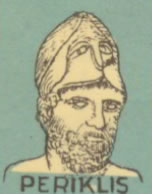Regarded as the greatest political leader of ancient Greece, Perikles was at the helm of the Athenian government for over thirty years, ruling it during its classical period.
 His father Xanthippos, was the general responsible for the defeat of the Persians at Mykale (479 BC), his mother Agariste, the neice of the founder of the Athenian democracy, Kleisthenis.
His father Xanthippos, was the general responsible for the defeat of the Persians at Mykale (479 BC), his mother Agariste, the neice of the founder of the Athenian democracy, Kleisthenis.
Perikles was born with a very long head, just days after his mother (according to legend) dreamed of giving birth to a lion. Artists most often portrayed Perikles wearing a helmet, perhaps to avoid his displeasure by depicting him with his long head. He was educated by the philosophers Zeno of Elea and Anaxagoras of Klaomenae, and became the first politician of ancient times to acknowledge the importance of such study for politicians.
He also studied musical theory with Damon and Pythokleidis. He became involved in politics at the age of 27, and was sponsored by the democratic faction, serving first as deputy leader, and then assuming primary leadership after the death of the incumbent, keeping this office until his death, being reelected again and again by the municipality of Athens.
More than any other one individual, he furthered the position of Athens as cultural and political center of Greece in his times, something implied in the name given the era: 'The Golden Age of Perikles'.
He founded colonies in southern Italy (referred to at the time as Magna Graecia), in Thurii, where such major figures as the Sophist philosopher Protagoras and the historian, Herodotos, settled, and another at Amphipolis, near the Strymon River in eastern Macedonia, the latter insuring an Athenian presence (and hence influence) over neighboring Thrace, and access to the considerable timber and minerals in the area.
He also established colonies in Amisus and Astakos in the region of the Sea of Marmara, a strategic area for control over the Dardanelles and the Bosporos, and on the islands of Evia (Euboea) and Naxos. All of these colonies assured the extension of Athenian influence, both economic and political in both the western and eastern Mediterranean regions, and resulted in great wealth for the city of Athens, which was used to realize the vision that Perikles nurtured for the creation of grand public works and the adornment of the city with eternal works of art.
To the sculptor, Phidias, was assigned the artistic supervison of the latter, on the main site for the realization of this dream, the hill of the Acropolis, the architects Iktinos and Kallikratis designers of the actual edifice of the Parthenon, in which Perikles' colossal ivory and gold statue of Athena Parthenon represented the presence of the goddess who temple this was.
The designer of the Propylaea was Mnesklis, and a conservatory built for musical competitions and the Theseion, a temple honoring the god Ifestos (Hephaestus) was also constructed. On Cape Sounion and at Ramnous, Doric temples were built, and Iktinos designed the Telesterio of Elefsis (Eleusis).
Piraeus was also made into a beautiful city, as befitted its status as largest port in all of the Mediterranean. As an individual, Perikles was known for his calm, dispassionate manner his high-mindedness, and perfectionism. His loyalties were with the democratic faction, as he sympathized with the poor masses rather than the small elite.